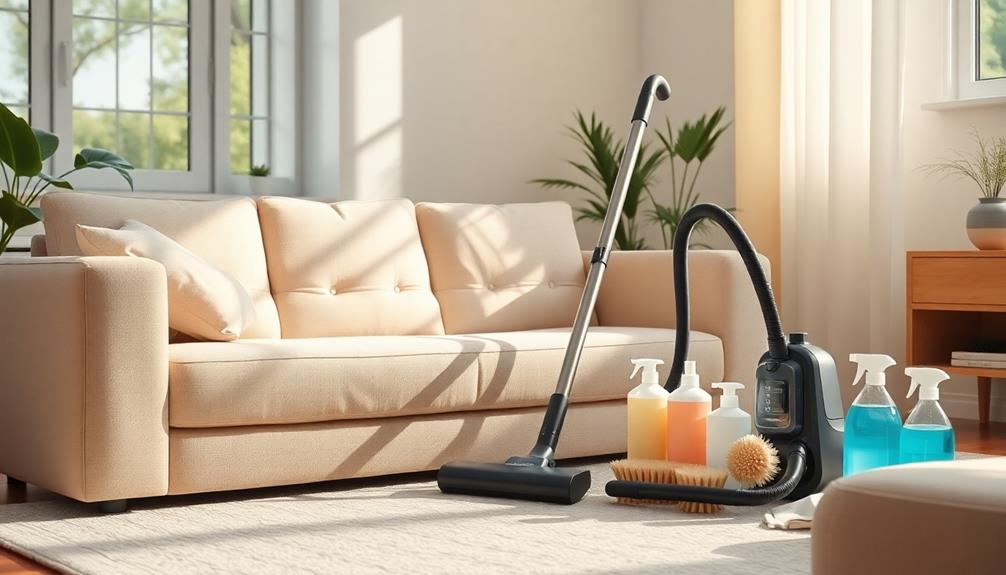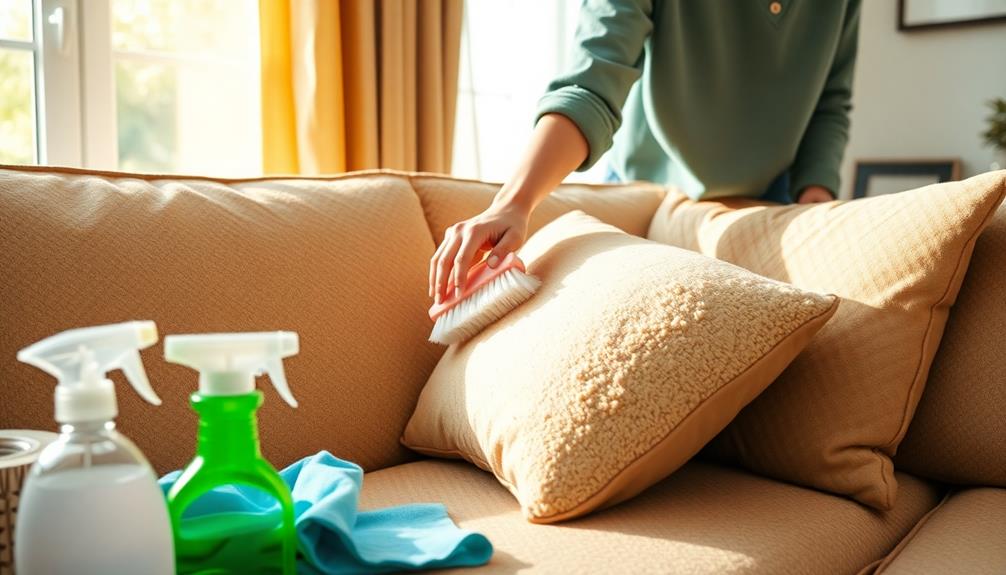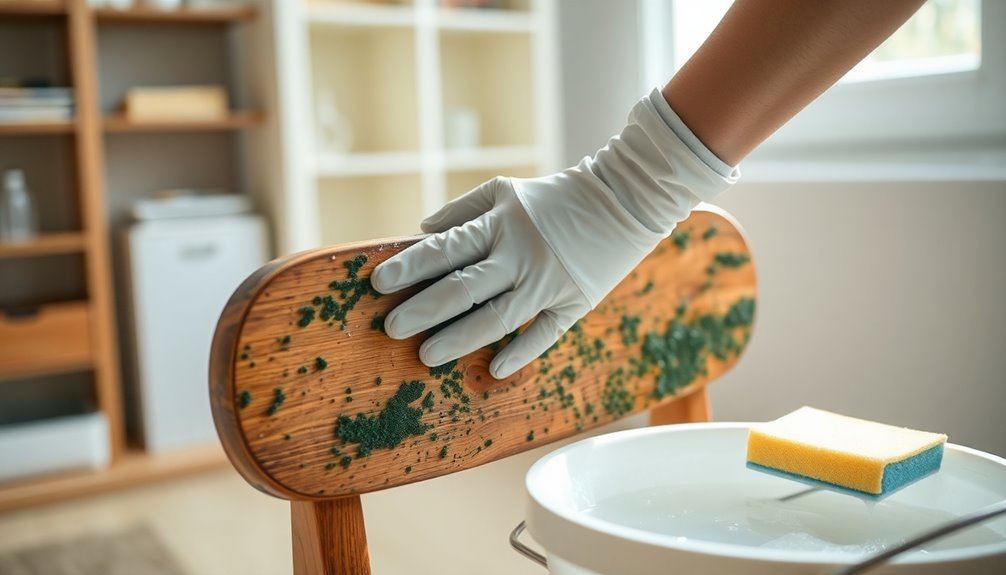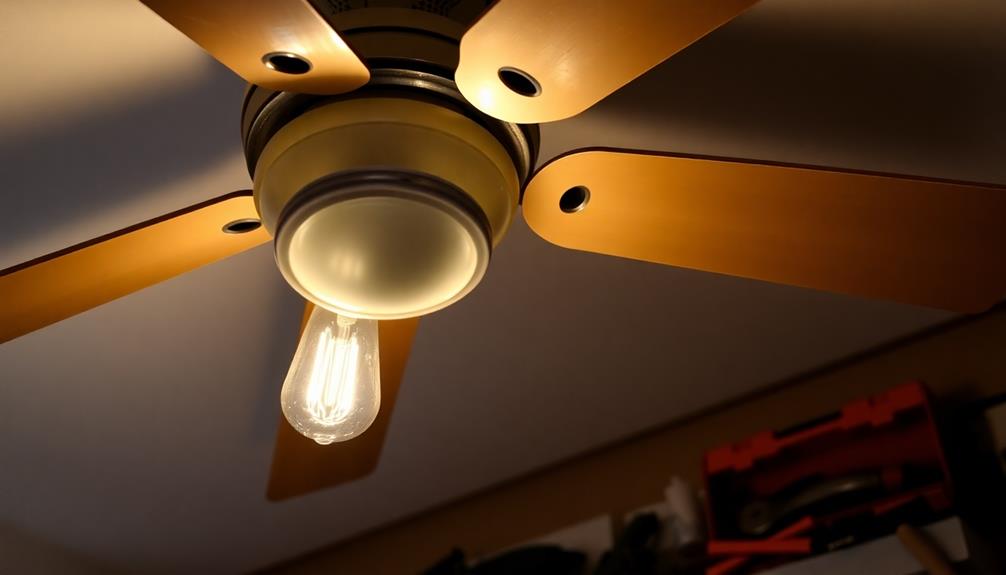To clean your sofa fabric at home, begin by referencing the manufacturer’s care tag for cleaning codes. Make sure to vacuum thoroughly to remove any loose dirt. For tough stains, mix distilled water, dish soap, and vinegar to create a solution. Gently blot the stain with a damp microfiber cloth and rinse with clean water. If your sofa is compatible, consider steam cleaning for a deeper clean. To combat odors, sprinkle baking soda or utilize a vinegar solution. Consistent maintenance such as vacuuming and fluffing cushions will help keep your sofa looking fresh. There are plenty more effective techniques to explore for cleaning various fabrics and odors. Additionally, it’s important to test any cleaning solution on a small, inconspicuous area of the fabric before applying it to the stain, ensuring it doesn’t cause discoloration or damage. For those looking for more options, researching additional cleaning fabric sofa tips can provide insights into specialized products tailored for specific fabric types. Don’t forget to regularly rotate cushions to prevent uneven wear and maintain the overall appearance of your sofa.
Key Takeaways
- Check the care tag for cleaning codes (W, S, WS, X) to determine suitable cleaning methods for your sofa fabric.
- Vacuum the sofa thoroughly to remove loose dirt and debris before applying any cleaning solution.
- For stains, create a solution of distilled water, dish soap, and vinegar, then gently blot the area with a microfiber cloth.
- Use a steam cleaner if the care tag allows it, ensuring to test on hidden areas first for safety.
- Regularly deodorize with baking soda and perform deep cleaning once or twice a year for optimal maintenance.
Importance of Manufacturer's Instructions
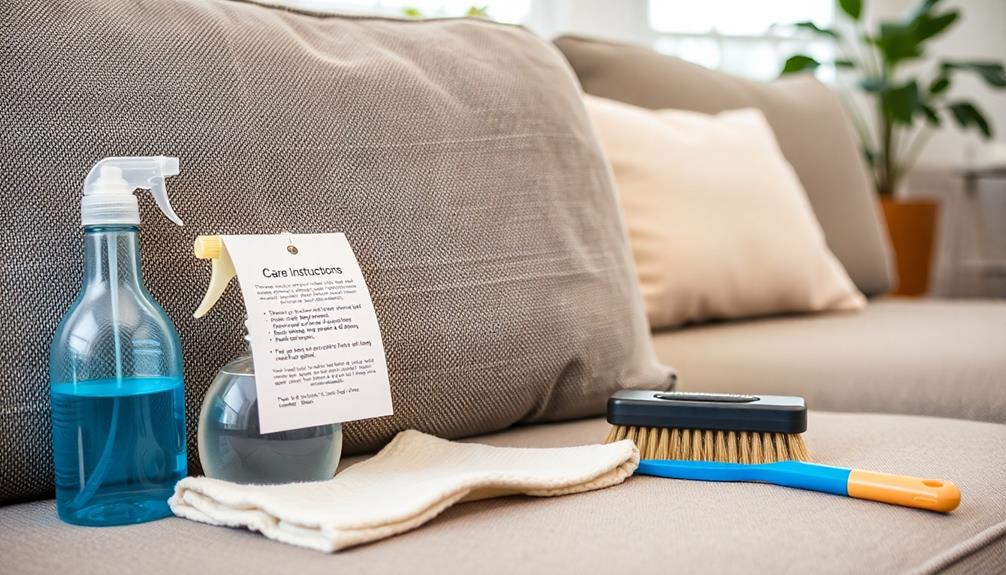
When tackling the task of cleaning your sofa, it's important to start by checking the manufacturer's instructions.
These guidelines are significant for preserving your upholstery and ensuring you use the right cleaning method. Ignoring them couldn't only void warranties but also damage the fabric, leaving you with costly repairs.
Additionally, understanding basic financial mistakes to avoid can help you allocate a budget for professional cleaning services if needed.
The care tags on your sofa cushions provide valuable information, including cleaning codes.
For instance, a "W" indicates that you can use a water-based cleaner, while an "S" suggests a solvent-based cleaner.
Understanding these cleaning codes is imperative; using the wrong method mightn't only fail to remove stains but could also worsen the situation.
Understanding Cleaning Tags
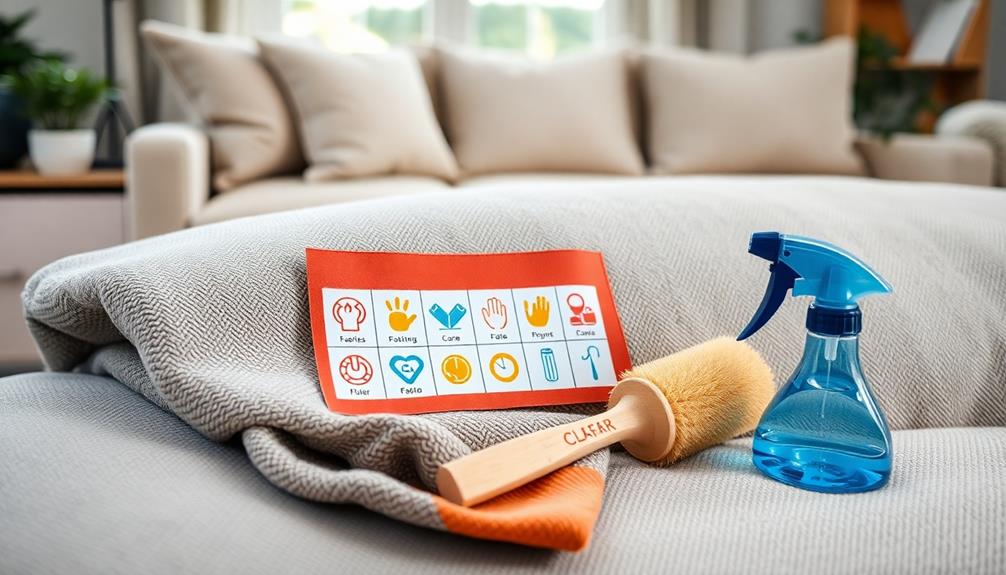
Cleaning tags are vital guides that help you determine the best way to care for your sofa fabric. Each tag typically features one of four codes: "W," "S," "WS," or "X." Understanding these codes is fundamental for maintaining your fabric's integrity.
For instance, using the right cleaning tools can enhance effectiveness, especially when considering options like best vacuums for dust removal in 2024 that can help keep your upholstery fresh.
If you see a "W" code, it means you can safely use water-based cleaning methods, such as steam cleaning or water-based solutions. On the other hand, fabrics with an "S" code should only be treated with solvent-based cleaners, as water can cause damage.
The "WS" code offers more flexibility, allowing both water and solvent-based cleaners, making it easier to choose a suitable cleaning method.
Lastly, an "X" code indicates that you should avoid any liquids entirely. Instead, stick to vacuuming or light brushing to keep your sofa clean.
Knowing these cleaning tags enables you to select the right approach for your upholstery cleaning machine or other cleaning tools without risking damage. Always refer to the cleaning tags to confirm you're using the appropriate cleaning methods for your sofa, preserving its appearance and longevity.
Cleaning Stained Fabric Sofas
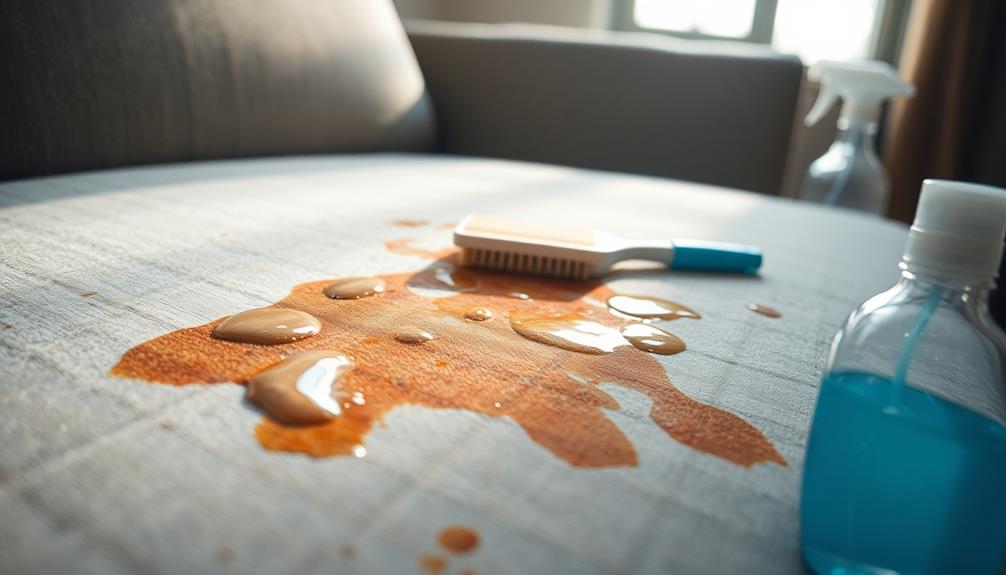
Over time, stains can accumulate on your fabric sofa, but tackling them effectively can restore its original beauty. Regular cleaning and maintenance of upholstered furniture can't only enhance its appearance but also prolong its lifespan.
Start by vacuuming the sofa thoroughly to remove loose dirt and debris, ensuring a clean surface for your stain treatment. Next, create a cleaning solution by mixing distilled water, dish soap, and vinegar in a bucket. This mixture works wonders in lifting stains without damaging the sofa fabric, similar to the importance of regular cleaning in maintaining other household items.
When you're ready to treat the stains, gently blot the affected area with a damp microfiber cloth soaked in your cleaning solution. Avoid scrubbing, as this can spread the stain or damage the fabric fibers.
After treating the stains, use clean water to rinse the area and blot again to remove any excess solution. To promote air dry, utilize a fan or open windows for proper air circulation, ensuring the cleaned areas dry completely to prevent mildew growth.
For persistent odors, sprinkle baking soda on the sofa, letting it sit for 20 minutes to 1 hour before vacuuming thoroughly. This step helps absorb and neutralize any remaining smells, leaving your sofa fresh and clean.
Steam Cleaning Techniques
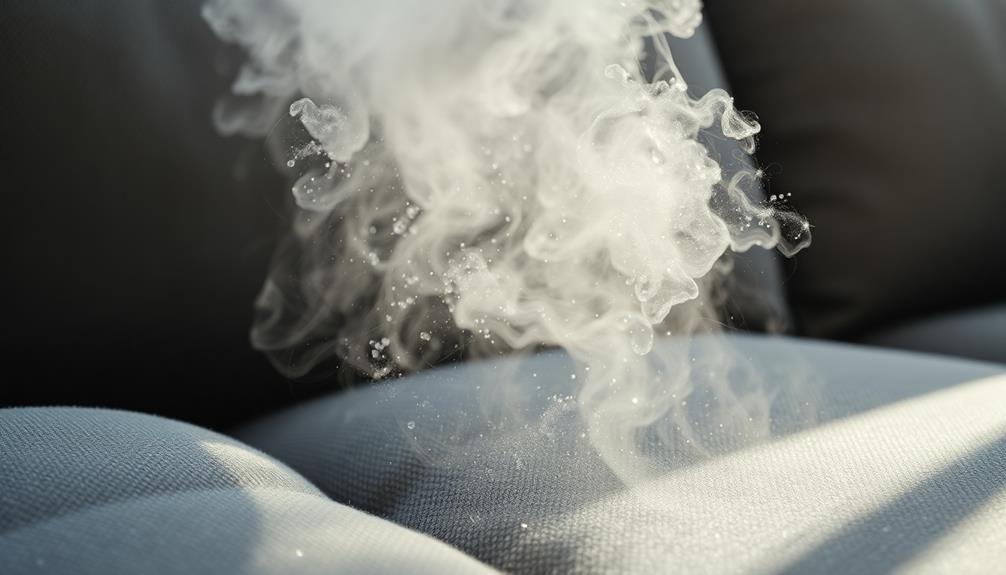
Often, steam cleaning is a highly effective method for revitalizing your fabric sofa and removing embedded dirt. Regular maintenance of your upholstery, similar to air purifier maintenance dos and don'ts, guarantees longevity and cleanliness.
Before you start, check the care tag to confirm it's suitable for water-based cleaning, marked with a W or WS. If it's labeled with an X, skip steam cleaning to avoid damage.
Begin by thoroughly vacuuming your sofa to remove loose dirt and debris. This step helps the steam cleaning process be more effective.
When you're ready, use the steam cleaner according to the manufacturer's recommendations. Always test the cleaner on a hidden area first to ascertain the fabric can withstand the steam.
For best results, open windows during the steam cleaning process to provide proper ventilation.
After you've cleaned the upholstery, allow the area to dry completely. You can speed up this process by using a fan.
Once everything is dry, vacuum the upholstery again to pick up any loosened dirt or debris that may have surfaced during cleaning.
Odor Removal Strategies
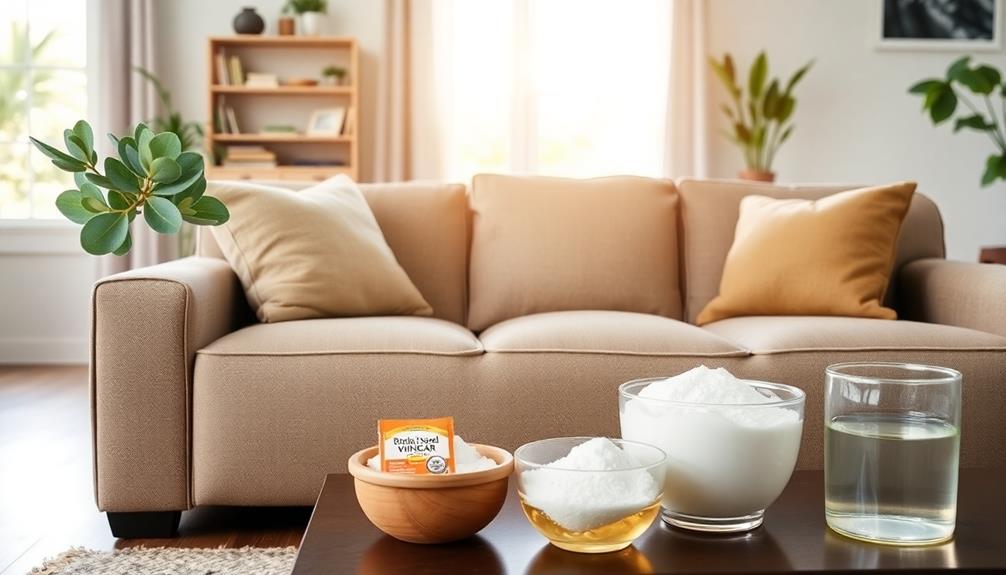
Unpleasant odors can linger in your fabric sofa, making your living space less inviting. To tackle this issue, start with baking soda, an effective odor absorber. Sprinkle it generously over the fabric surface and let it sit for 20 minutes to 1 hour.
Once it's absorbed the odors, simply vacuum it off for a freshening effect. Additionally, consider the importance of regular cleaning and maintenance to prevent odor buildup, as noted in cold medications overview.
For persistent smells, create a vinegar solution by mixing equal parts distilled vinegar and water. Lightly spray this solution on the fabric and blot with a clean cloth to neutralize the odors.
Make sure the area dries completely afterward to prevent mildew—using a fan or opening windows can help with ventilation.
Regular vacuuming of your sofa, particularly in crevices and under cushion covers, is essential for effective odor removal. This practice not only eliminates trapped dirt but also helps get rid of lingering smells from food, pets, or spills.
Additionally, when washing removable cushion covers, consider adding baking soda to the wash cycle for extra deodorizing power. By following these strategies, you'll keep your sofa smelling fresh and inviting.
Cleaning Tools and Supplies
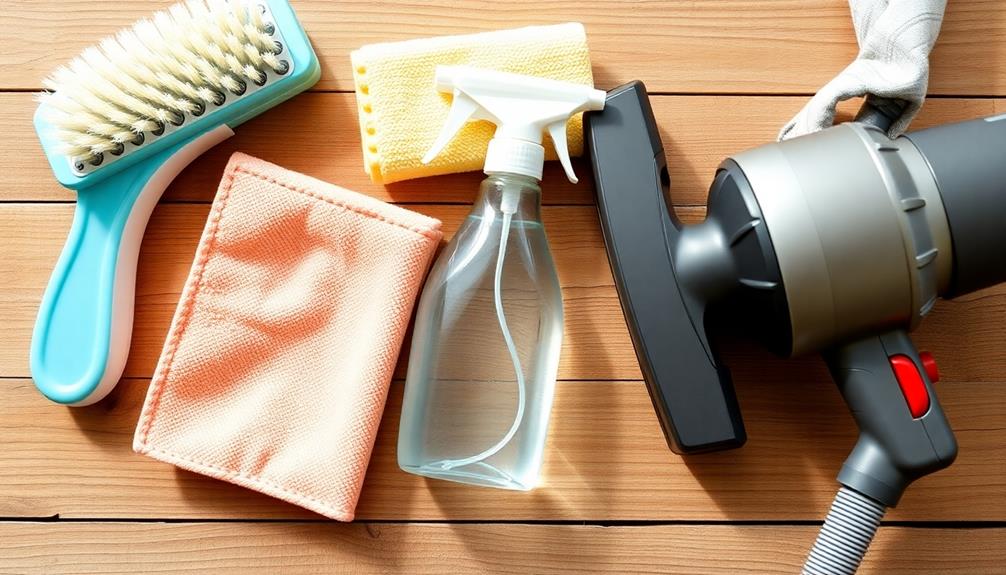
To keep your sofa looking its best, you'll need some essential cleaning tools and recommended products. A vacuum cleaner with upholstery attachments, a portable cleaner, and a lint brush are must-haves for maintenance.
Additionally, consider using natural remedies like essential oils for their antimicrobial properties, which can help eliminate odors and maintain fabric freshness, such as essential oils for respiratory health.
Don't forget about baking soda and protective sprays like Scotchgard to tackle stains and enhance your fabric's longevity.
Essential Cleaning Tools
When it comes to keeping your sofa fabric clean, having the right tools on hand makes all the difference. To effectively clean a fabric sofa, start with a Dyson Vacuum. This powerful vacuum efficiently removes dust and crumbs from your sofa and couch cushions, ensuring a thorough clean before you immerse yourself in the cleaning process.
Additionally, consider using appliance maintenance plans to regularly maintain your cleaning tools, as this can extend their lifespan and improve efficiency.
Next, a lint brush is perfect for quick touch-ups, helping you easily remove hair and dust to keep your upholstery looking fresh. For deeper stains, the Bissell Little Green Machine is an invaluable portable upholstery cleaner that tackles tough marks with ease.
To enhance your sofa's appearance, consider using a fabric shaver to eliminate pilling and fuzz, giving your fabric a refreshed look.
After cleaning, protect your sofa with Scotchgard. This protective spray creates a barrier against spills, making it easier to maintain cleanliness and preventing future stains.
With these essential cleaning tools, you're well-equipped to deep clean and maintain your sofa fabric, ensuring it remains inviting and looking its best for years to come.
Recommended Cleaning Products
For keeping your sofa fabric in top shape, selecting the right cleaning products is essential. Start with a reliable upholstery cleaner like the Bissell Little Green Machine, which excels at tackling deep stains and is perfect for spot cleaning pet stains.
For regular cleaning, a Dyson Vacuum is great for removing dust and crumbs before you dive deeper into couch cleaning. Additionally, consider using a best airless paint sprayer for any touch-up work on your walls after cleaning your sofa—this will enhance your living space's overall appearance.
If you prefer DIY cleaning solutions, mix distilled water, clear Dawn dish soap, and distilled white vinegar. This combo creates an effective and safe cleaner for various fabric types. Simply spray it on the stained area and blot with a clean cloth.
After cleaning, consider applying Scotchgard to protect your sofa. This protective spray creates a barrier against stains and spills, helping maintain your fabric's look. Remember to reapply it periodically for maximum effectiveness.
Lastly, keep a lint brush handy for quick touch-ups. This tool helps you easily remove hair and dust, making your sofa look well-maintained between deep cleanings.
With these recommended cleaning products, your sofa will stay clean and fresh for a long time.
Regular Maintenance Tips
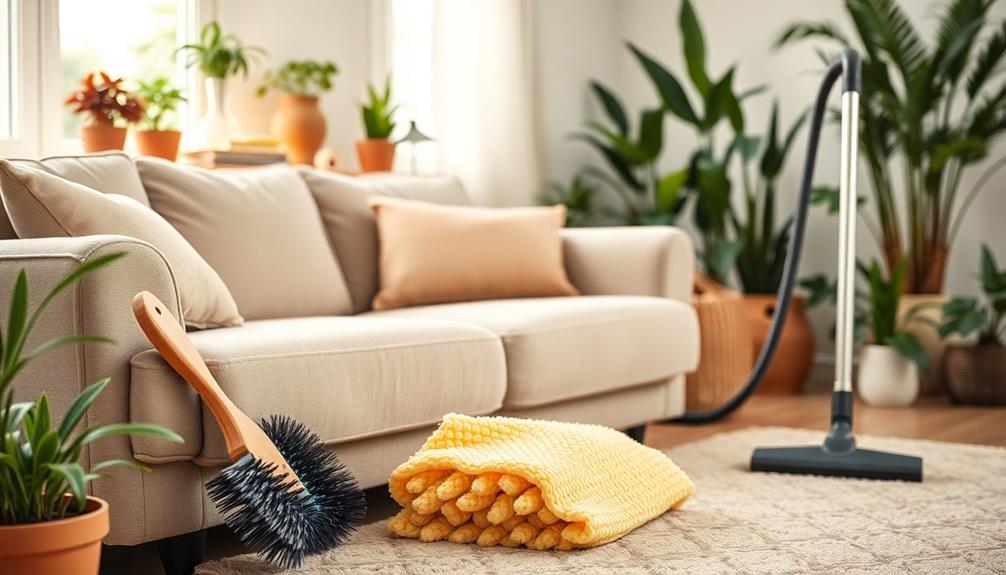
To keep your sofa looking its best, frequent vacuuming is essential. Aim for at least once a week to remove dust, crumbs, and pet hair that can lead to stains.
Regular maintenance of your home environment, including minimizing clutter and using protective covers, can also prolong the life of your furniture and reduce cleaning needs.
Additionally, consider the importance of financial considerations for elderly care when investing in quality upholstery that withstands wear and tear.
Fluffing and rotating your cushions every few weeks not only maintains their shape but also enhances your comfort.
Frequent Vacuuming Importance
Keeping up with regular vacuuming is vital for maintaining your sofa's fabric and overall cleanliness. Frequent vacuuming helps eliminate dust, crumbs, and allergens that can accumulate on the fabric, greatly improving indoor air quality.
Additionally, understanding the proper diet for pets can further enhance the cleanliness of your home by minimizing pet-related mess. Aim to vacuum your sofa at least once a week, paying close attention to crevices and under removable cushions. This practice prevents dirt buildup and extends the life of your upholstery.
Using a vacuum equipped with an upholstery attachment, like a Dyson or Shark Navigator, guarantees effective removal of pet hair and debris from the fabric surfaces. Don't forget to lift and vacuum both sides of your removable cushions; this thorough cleaning technique helps prevent odors and stains from setting in.
Regular vacuuming not only maintains your sofa's appearance but also prepares the fabric for deeper cleaning methods. By enhancing hygiene, you create a more pleasant environment in your home.
Cushion Fluffing Techniques
Regular vacuuming sets the stage for maintaining your sofa's appearance, but don't overlook the importance of fluffing your cushions. Fluffing helps restore their shape and prevents that lumpy look that can detract from your sofa's aesthetic. To fluff cushions effectively, shake them out gently or hit them against a soft surface to redistribute the filling evenly.
It's a good idea to rotate your cushions frequently, ideally every few months, to guarantee even wear and tear and prolong their lifespan. This simple step helps maintain comfort and keeps them looking fresh.
If you have down-filled cushions, core shaking can prevent feathers from clumping, ensuring they stay cozy and inviting.
Don't forget about removable cushion covers! Launder them periodically according to care instructions to enhance cleanliness and freshness.
Deep Cleaning Techniques
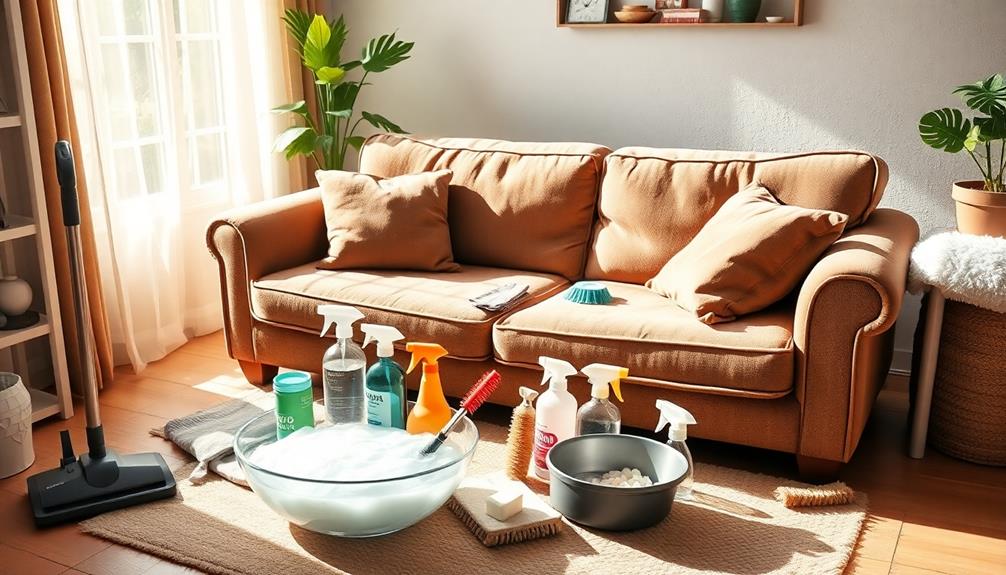
Deep cleaning your sofa fabric is essential for maintaining its appearance and hygiene, especially if you have pets or a busy household.
To effectively clean a couch, consider using an upholstery cleaning machine like the Bissell Little Green Machine. This tool excels at tackling large stains and embedded dirt, giving your sofa a thorough refresh.
Before applying any cleaning solution, always perform a spot test on a hidden area of the fabric to check for color loss or damage.
If your sofa has removable cushion covers, wash them in a cold/gentle cycle using OxiClean and baking soda to restore their brightness.
For general maintenance and deep cleaning, create a DIY cleaner by mixing distilled water, dish soap, and vinegar in a spray bottle. This solution works wonders for routine upkeep and can be used during your deep cleaning sessions.
Remember, regular deep cleaning is recommended at least once or twice a year to keep your sofa looking its best.
User Experiences and Best Fabrics
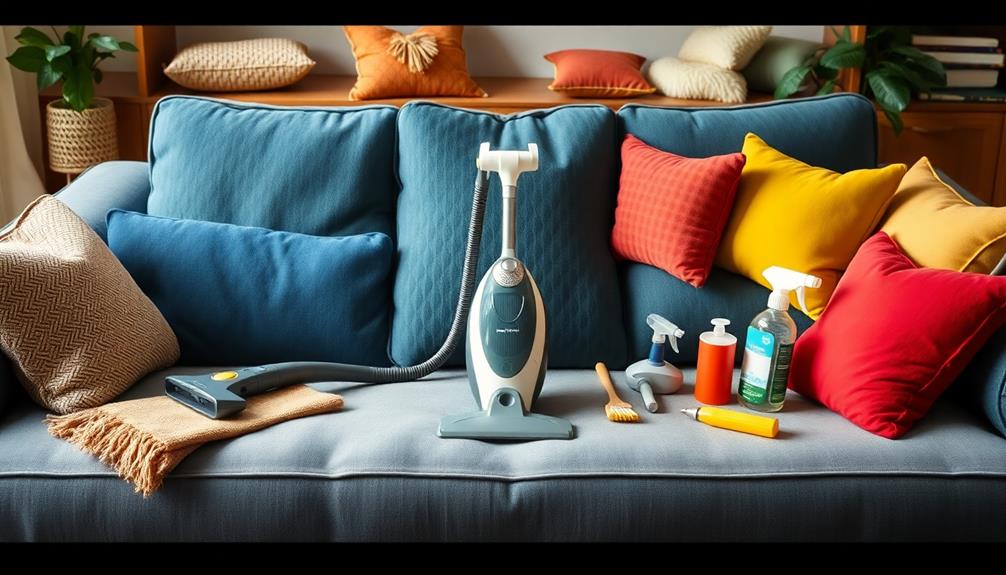
When it comes to choosing the best fabrics for your sofa, user experiences offer valuable insights. Many users rave about synthetic microfiber couches for their stain resistance and minimal maintenance, making them ideal for homes with kids and pets.
They're not only easy to clean but also dry quickly after cleaning, which simplifies upkeep.
For stubborn stains, OxiClean has gained a reputation among users as a go-to solution. Many appreciate its effectiveness on various upholstery types, making it a staple in their cleaning routine.
However, it's essential to remember that printed fabrics can be tricky; users often report issues like color bleeding during cleaning, so always prioritize spot testing before applying any cleaner.
Frequently Asked Questions
What Is the Best Way to Clean a Fabric Couch?
To clean your fabric couch effectively, start by checking the cleaning tag. Vacuum thoroughly, then use a gentle mixture of water, dish soap, and vinegar to blot stains. Always spot test first to avoid damage. After treating the stains, allow the area to air dry completely, and avoid direct sunlight to prevent discoloration. For regular upkeep, vacuum your couch weekly to remove dust and dirt that can accumulate over time. Following these cleaning tips for fabric upholstery will help maintain the appearance and longevity of your furniture.
How Do You Clean a Fabric Couch Without Washing It?
Imagine your couch as a favorite book. You wouldn't toss it in water. Instead, vacuum it, gently blot stains, sprinkle baking soda, and steam clean if possible. Regular care keeps it looking like new.
Can I Use Dawn Dish Soap to Clean My Fabric Couch?
Yes, you can use Dawn dish soap to clean your fabric couch. Mix two tablespoons with two cups of distilled water, blot stains gently, and always spot test to avoid any potential damage.
How to Deep Clean a Sofa at Home?
Imagine your sofa as a weary traveler, longing for rejuvenation. To deep clean it, vacuum thoroughly, mix a gentle solution, blot lightly, and consider an upholstery machine for stubborn stains. Let it breathe, and it'll shine anew!
Conclusion
To sum up, keeping your sofa clean not only enhances its appearance but also extends its lifespan. Did you know that a well-maintained fabric sofa can last up to 15 years longer than one that's neglected? By following the manufacturer's instructions, understanding cleaning tags, and implementing regular maintenance, you can enjoy a fresh and inviting living space. Remember, a clean sofa is a happy sofa, so invest a little time in its care for long-term rewards!
